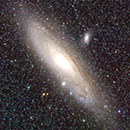M31: stellar content and microlensing
The Andromeda galaxy (also called M31 or NGC 224) is the closest large spiral galaxy at a distance of 770kpc (2.5 million light yrs). M31 and the Milky Way together define the dominant mass components of the local group. In the figure shown above one can see that M31 has a bulge component dominating the central light distribution and spiral structures dominating the outskirts. By observing the dynamics of stars in the center of M31 at high spatial resolution with the STIS spectrograph on the Hubble Space Telescope Ralf Bender [Bender et al. 2005] showed that there is a black hole at the center of M31 with a mass of about 108 solar masses. It is interesting to investigate M31 in detail, to compare it to our Milky Way and try to understand the differences in their central black holes, their stellar dynamics and stellar populations and dark matter halos, to understand the Local group (its origin and future evolution), and to use it as a "bridge" to obtain experience in analysing more distant galaxies with apparantly fainter stellar populations and reduced spatial resolution.
To understand a galaxy one tries to determine properties of the main components, i.e. the black hole mass, the masses (mass distributions) and stellar ages (stellar age distributions) of its bulge and disk and then one infers the properties of the dark matter halo this galaxiy has to be embedded in order to match all observations. Hence, one indirectly infers it dark matter distribution.
In a work lead by Roberto P. Saglia [Saglia et al. 2010] at the OPINAS-MPE part of our group we showed that the M31 bulge is heavier by a factor 2 than previously thought and that its main stellar population component is old (>12 Gyrs), with a central stellar population (likely related to a recent merger) as young as 4-8 Gyrs. More recently we have analyzed within the PhD project of Michael Opitsch the dynamics of stars and gas in the M31 bulge and disk to great detail [Opitsch et al. 2017] and we have shown that M31 also has a "bar" like our own Milky Way - this bar is very difficult to detect in the photometry of M31 alone, since this galaxy has such a large inclination angle (77 degrees). Another recent work lead by the PhD student Matias Blana at MPE [Blana et al. 2017] reveiled that the M31 bulge consists of a low dispersion "classical bulge" and a high dispersion, so-called "PB-bulge" forming after the classical bulge. This work also confirmed the high mass of the total bulge (at ~3x1010 solar masses). The non-stellar, "dark mass" component of M31 was estimated to be 1010 solar masses (within the radius of the bulge of 3.2 kpc). Hence the interior matter distribution of M31 is well constrained.
A fraction of the Dark Mattter could be explained by a population of early stars that have already developed into White Dwarfs, Neutron Stars or Black Holes and are therefore invisible to our telescopes. Such massive and compact but dark objects (MACHOs) can be indirectly detected by the gravitational lens effect [Riffeser et al. 2001, Riffeser et al. 2003]. A gravitational lens distorts the space-time in such a way that the beams of stars lying behind reach us only on curved paths and are therefore amplified. The magnification is dependent on the projected distance of the source from the lens. Since all objects move relative to each other, a characteristic change in brightness is obtained, which is the same in all colors. This allows us to distinguish between gravitational lensing light curves and brightness fluctuations of variable stars. Since the approximation of the light beam to the gravitational lens must not be much larger than the Einstein radius, only one measurable gravitational lens effect occurs when 10 million stars are observed.
In M31 one has the possibility to examine 100 billion stars for brightness fluctuations at the same time. But one of the difficulties is that the stars are no longer resolvable, so many stars overlay. Since the intrinsic brightness of the star can no longer be determined, we try to investigate the mass distribution of the lenses by statistical methods . This requires an exact knowledge of the composition and dynamics of M31 [Riffeser et al. 2006, Riffeser et al. 2008, Lee et al. 2012, Lee et al. 2015].
Variable stars [Fliri et al. 2006] are good indicators for the star populations and the history of star formation, which in turn affects the composition of M31. In addition to Novae in M31 [Pietsch et al. 2006, Lee et al. 2012] also Cepheids can be detected very well. Since they also serve as standard candles for the local universe, they are essential for the derivation of the local Hubble constant, which in turn limits all cosmological models. The detection of the Cepheids [Kodric et al. 2013] is obtained in optical data with 1-2 meter class telescopes (e.g. Wendelstein 2m telescope). The period-luminosity relation in the near infrared can then be obtained from the photometry of Hubble Space Telescope data at the detected positions [Kodric et al. 2015] and then applied to other galaxies in the local universe. Thus the universe can be measured based on the Cepheid measurements in M31.


